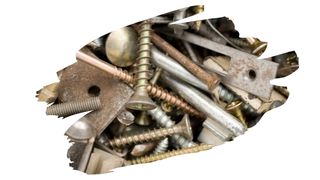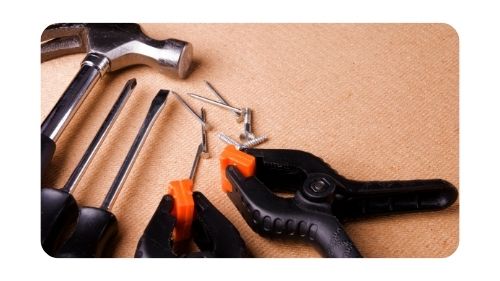Come wind, rain or shine, this type of wood can weather the elements just as well as it can resist bugs and insects.
And just what kind of wood can do all of this? Needless to say, the simple answer to that is pressure treated wood.
This preservative infused lumber has been treated so that wood can better resist rot, decay and insects. Which is precisely what you need if you plan on using that timber to create outdoor structures and building work.
But, while the preservatives in those pressure treated boards are great at protecting wood, they don’t play so nicely when it comes to metal.
In fact, a lot of the preservatives infused into pressure treated lumber are corrosive enough to eat away at metal such as steel.
Which means if you want to fasten those treated boards, what are your options? And should you use nails or screws on pressure treated wood at all?
When it comes to pressure treated wood you should use hot-dipped galvanized nails and screws. These corrosion-resistant fasteners have been coated with zinc, which helps to keep them from rusting away. You can also use stainless steel nails and screws made from grade 304 and grade 316 stainless steel.
Now, when it comes down to deciding between say a galvanized nail or a galvanized screw, your choice depends more on your type of project. Or, to be more precise, it depends on the amount of load those pressure treated boards will be expected to hold.
If your pressure treated wood board is going to be used to hold up heavy loads, then nails are a better choice. That is because nails can handle structural loads without snapping under shear pressure.
Otherwise, screws would be your best option, because they hold wood together more firmly and securely. Sure, screws may be more brittle than nails, but they won’t loosen and lose their grip the way a nail can.
Related Post: 5 Reasons Why Screws Won’t Go All The Way Into Wood (+ A Quick Fix)
Is It Better To Nail Or Screw Pressure Treated Wood? Ideally use screws to fasten wood, as screws are better at holding boards tightly together. But, you should use nails to fasten load-bearing pressure treated wood boards, as nails have more shear strength.
So, provided you use galvanized nails and/or screws, those fasteners should hold up well when used in pressure treated lumber.
But, you must make sure you get the right type of galvanized nails. This is key. And if you keep reading, we’ll cover that topic and more besides in the rest of this article…

This post may contain affiliate links to products that we receive a commission for (at no additional cost to you). Learn more here.
So, What Type Of Screws And Nails Must Be Used In Pressure Treated Lumber?
If you plan on using any type of metallic fastener on pressure treated wood, then it needs to be rust-resistant. This is regardless of whether you’re crafting an outdoor project or doing interior decorating.
That’s because pressure treated wood is chock-full of chemicals that will happily eat away at metal such as steel and copper.
So, you need to use nails and screws made from stainless steel. Or use nails or screws that have been galvanized.
Stainless steel fasteners, (specifically ones made from grade 304 or 316 stainless steel), won’t react with pressure treatment chemicals. This is all thanks to something called chromium. This is a trace material that has been added to stainless steel to give it that rust-proofing power.
Can You Use Stainless Steel Screws In Pressure Treated Wood? Yes, you can. The chemicals found in pressure treated wood won’t corrode away grade 304 and grade 316 stainless steel fasteners.
There is another type of metal that is pretty resilient when it comes to corrosion… and that metal is zinc.
Just to be clear, zinc is not rust proof. And just like steel, it will corrode when exposed to water and air. However, zinc corrodes at a much, much slower pace than other metals.
So, to protect screws and nails from corrosion, manufacturers put them through a process that coats them in zinc. This process is referred to as galvanizing.

Are All Galvanized Nails And Screws OK For Pressure Treated Wood?
It depends on the type of process used to galvanize that nail or screw.
When we say that a nail/screw fastener is galvanized, we’re basically saying that it is wholly coated in zinc. And that zinc coating is what protects those fasteners from corrosion.
But, if that coating of zinc is too thin, then it doesn’t provide much protection from corrosion at all.
So, there are two main ways to galvanize nails and screws; hot-dipping, and electrical current.
Related Post: A Quick Guide To Painting Landscape Timbers (+ 3 Easy Time Saving Tips!)
Hot-Dipped Galvanized Nails/Screws (Hot-Dipping)
This galvanizing process involves dipping nails or screws into molten zinc. This piping hot zinc covers those nails and screws in a thick coating. And, after it cools down, that coat of zinc is highly rust-resistant.
This type of galvanized nail/screw works well with pressure treated wood.
Electro-Galvanized Nails/Screws (Electrical Current)
This process involves dipping nails/screws into zinc as well. Except this time, instead of molten zinc, we use an electrical current to draw all of that zinc onto that fastener. This coats it with a thin film of zinc.
The problem with using electro-galvanized nails boils down to that thin coat. The zinc coats on these types of galvanized fasteners are up to 10 times thinner than a hot-dipped galvanized zinc coating.
In other words, you should not use electro-galvanized nails/screws to fasten pressure treated wood.
When Should I Only Use Screws Vs Nails?
When it comes to outdoor projects that require dense heavy lumber, stick to using nails.
Here’s why: wood moves around a lot when left outdoors. Rain, moisture, heat – all that stuff makes wood expand and contract throughout the seasons.
Even well-seasoned wood will need a little wiggle room (which is something we cover more about here: How To Season Wood (7 Tips))
But why exactly do nails hold up better outdoors? Well, because nails allow for wood to have subtle movement while still keeping everything where it needs to be.
You see, nails are champs at handling shear pressure, like when weight is applied straight down on the fastener.
Think of a deck railing – all that downward pressure from people leaning on it. Well, in that instance, nails will hold steady. While screws are more prone to snapping.
Now, we don’t want to make it sound like screws should never be used with pressure treated wood outdoors. Screws definitely have their benefits too…
For example, the main advantage of screws is they hold boards together more tightly than nails. That can be useful if you really need a super snug, flush fit between two pieces of wood.
Screws also tend to stay fixed in place longer over time. While nails can eventually work themselves loose as the wood expands and contracts. Not a huge issue, but screws will maintain that tight grip for longer.
So screws aren’t a total no-go. They can be the better choice if you need a really rigid, permanent join between boards. Or if you simply plan on making a light-weight construction such as a birdhouse or chicken coop.
In fact, we dive more into using pressure treated wood for chicken coops in our post here: Is Pressure Treated Wood Safe For Chicken Coops? (Or Will Using Treated Wood Hurt My Chickens)
What Kind Of Nails Should You Use For Pressure Treated Wood? You should use hot dipped galvanized nails to fasten pressure treated wood into place.
So To Sum Up…
If you want pressure treated wood to stay in it’s place, then it needs a special type of fastener.
So, hot galvanized nails and screws, or ones made from 304 or 316 graded stainless steel are your best choice with this type of lumber.
Not only are they highly rust resistant, but they can also hold their own against those corrosive pressure treated preservatives.


